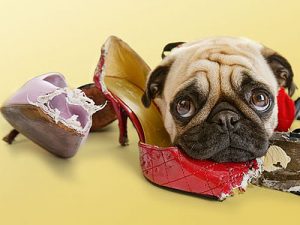ESOPHAGEAL OBSTRUCTION IN DOGS
Dogs tend to eat unusual things. When a dog ingests foreign material or foodstuffs too large to pass through the esophagus (the throat), the esophagus can become blocked. Small-breed dogs, especially terriers, are most apt to have esophageal foreign bodies. Esophageal foreign bodies cause mechanical blockage, swelling, and death of the throat tissue.
SYMPTOMS AND TYPES
- Retching
- Gagging
- Loss of energy
- Loss of appetite
- Depression
- Excessive salivation, drooling
- Regurgitation
- Restlessness
- Trouble swallowing
- Trouble breathing
- Persistent gulping
CAUSES
Obstruction of the esophagus occurs with objects that are of a size, shape, or texture that will cause them to get stuck in the esophagus.
DIAGNOSIS
You will need to give a thorough history of your dog’s health, onset of symptoms, and possible incidents that might have led to this condition. You should describe anything your think your dog might have eaten that could have become lodged in its throat (e.g., toys, panties, golf balls). Your veterinarian will do a physical exam, with an X-ray of the esophagus and chest. Another diagnostic tool that is useful for imaging is an esophagoscope, for seeing the interior of the esophagus. These imaging steps are crucial for making a concrete diagnosis and for making an accurate estimation of the exact place in the esophagus that is being affected, and of the degree of damage caused to your dog’s esophagus. Standard tests will also include a chemical blood profile, complete blood count, urinalysis and an electrolyte panel. Usually, the bloodwork results will return as normal.
TREATMENT
Your veterinarian will need to remove the object. If it is not deeply lodged in the throat, your doctor may be able to use using an endoscope, a small tube-like instrument with a camera and small tongs attached, which is as minimally invasive as possible. If it is not possible to remove the object using this tool, or if your dog’s esophagus is severely damaged (the tissue has necrotized, or has a hole in it), your veterinarian will need to perform surgery to remove the object and to repair the esophagus. If your dog’s esophagus is very badly damaged, your veterinarian will prescribe 10 to 14 days of antibiotics, along with some medications to treat the esophageal inflammation and pain.
During the recovery period, it is probable that you will need to have a stomach tube inserted into your dog in order to protect the esophagus while still allowing your dog to digest food and maintain a healthy weight.
LIVING AND MANAGEMENT
You will need to take your dog back to see the veterinarian several days into the recovery to make sure that the throat is healing properly, and again after a couple of weeks. If during this period of healing your dog begins to vomit, have problems breathing or standing, or exhibits any other abnormal changes or behaviors, you should immediately notify your veterinarian. Severe complications can ensue when the esophagus has been badly damaged.
If your dog needed to have surgery to remove the object, you should expect your dog to feel sore for some time while the surgical site heals. Your veterinarian will give you pain medication for your dog to help minimize discomfort, and you will need to set up a place in the house where your dog can rest comfortably and quietly, away from other pets, active children, and busy entryways. Trips outdoors for bladder and bowel relief should be kept short and easy for your dog to handle during the recovery period. Use pain medications with caution and follow all directions carefully; one of the most preventable accidents with pets is overdose of medication.
PREVENTION
Because dogs are known for picking things up in their mouths, either to chew on them, or because it smells or looks like food, you are the best line of defense in protecting your dog from swallowing inappropriate items. Make sure that small objects are not left within reach of your dog. Indoors, children’s toys, and chew toys are commonly swallowed, as well as utensils, hair ties, socks and underwear.
Outdoors, you will need to keep an eye on your dog, since you cannot control the natural environment. Sticks, rocks, and bones are all commonly swallowed objects.
~At Heart Arrow We Love Pets~


